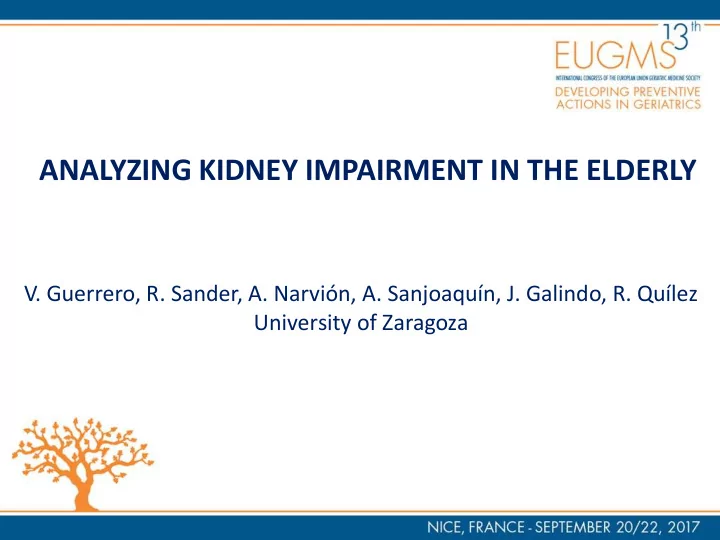

ANALYZING KIDNEY IMPAIRMENT IN THE ELDERLY V. Guerrero, R. Sander, A. Narvión, A. Sanjoaquín, J. Galindo, R. Quílez University of Zaragoza
CONFLICT OF INTEREST DISCLOSURE We have no potential conflict of interest to report
INTRODUCTION The Chronic Kidney disease (CKD) has a high prevalence in the elderly population (over 65 years). Spain 23.6%, the United States 23%, Canada 35.7% and Finland 35.8%. Formulas like MDRD4, CG and CKD-EPI overestimate the glomerular filtrate in the elderly population. However, only the Berlin Initiative Study (BIS1) formula has been studied in the elderly population and has not been shown to be superior to CKD-EPI. In 2011 a new formula to estimate glomerular filtration rate (GFR) was created, called HUGE formula (hematocrit, urea and gender). It will help to assure if the GFR is reduced below 60 ml/min it is due to a physiological process associated with aging or due to true CKD.
OBJECTIVES Primary Objective: • To evaluate the sensitivity and specificity of the MDRD4, BIS1 and CG formulas, comparing them with CKD-EPI as a reference formula for the diagnosis of CKD in elderly patients older than 90 years Secondary objectives: • To evaluate if the HUGE formula has a prognostic value in patients older than 90 years with GFR less than 60ml / min / year. • To analyze the association between comorbidities and glomerular filtration.
METHODS Prospective longitudinal cohort study. Study the characteristics of patients over 90 years seen in the out patient clinic between 2015 and 2016 in Huesca. Also Socio-demographic data, comorbidity, analytical results and drugs were recorded. All collected data was analyzed with Statistical analysis SPSS 23.
RESULTS Comorbidity PERCENTAGE CKD* 41% A total of 288 patients with a mean age 94.5 ± 2.4 years, in which 69.8% were female, HTA* 78,5% mean Barthel index of 70, survived the year DM 29,2% 81.3%. Dyslipedemia* 45,1% Coronary heart 13,9% disease Cancer 21,9% Hyperuricemia 19,1% Stroke 18,1% Heart Failure 23,6% Nephrolithiasis 2,8% Anemia* 35,2%
RESULTS Drugs DRUGS PERCENTAGE NSAIDS 7% ACE 17,8% ARB * 33% Thiazides 17% Metfomin 8% Loop Diuretic* 39,6% NSAIDS: non-steroidal anti-inflammatory drugs. ACE: angiotensin converting enzyme inhibitors. ARB: angiotensin receptor blockers .
RESULTS DEGREE OF KIDNEY FAILURE VS FORMULAS 90,00% 80,00% 79,90% 70,00% % OF PATIENTS 60,00% 57,60% 50,00% 50,30% 53,50% 40,00% 42,40% 38,50% 35% 30,00% 12,80% 20,00% 7,30% 10,80% 10,00% 7,30% 3,80% 0,00% NORMAL MILD- MODERATE SEVERE DEGREE OF RENAL FAILURE CG CKD-EPI MDRD4 BIS1 This graph represents the percentages of patients who have each degree of renal failure according to each formula.
RESULTS GLOMERULAR FILTRATION RATE eGFR GLOMERULAR FILTRATION RATE This graph represents the mean glomerular filtrates according to each formula .
RESULTS PATIENTS WITH eGFR LOWER THAN 60ML/MIN BIS1 92,70% FÓRMULAS CKD-EPI 64,20% MDRD4 49,70% CG 96,20% 0,00% 20,00% 40,00% 60,00% 80,00% 100,00% 120,00% % PATIENTS WITH GFR LOWER THAN 60 CG MDRD4 CKD-EPI BIS1 This graph represents the percentage of patients with GFR lower than 60ml / min with the different formulas.
RESULTS GFR THROUGHOUT 1 YEAR GFR INITIAL 3 MONTHS 6 MONTHS 9 MONTHS 1 YEAR This graph represents how glomerular filtration behaves throughout the follow-up year, with each formula.
RESULTS HUGE [VALORE] [VALORE] CKD Physiological This graph represents the result of the HUGE formula, which was performed on patients with less than 60ml / min of glomerular filtration per CKD-EPI formula.
RESULTS SENSITIVITY AND SPECIFICITY 100% 100% 100% 100% 100% 95,90% 93,50% 82,90% 77,30% 74,20% 10,70% 8,60% 20,40% 12,90% CG MDRD4 BI1 CKD-EPI SENSITIVITY INITIAL 100% 77,30% 100% SPECIFICITY INITIAL 10,70% 100% 20,40% SENSITIVITY PER YEAR 100% 82,90% 100% 95,90% SPECIFICITY PER YEAR 8,60% 93,50% 12,90% 74,20% This graph represents the sensitivity and specificity, from the start of the study, compared with CKD-EPI and yearly follow-up.
RESULTS An area under the curve (AUC) was obtained for CG of 89.2% and for MDRD4 and BIS1 of 99.8%. Always compare them with CKD-EPI
RESULTS Yauden Index FORMULAS SENSITIVITY SPECIFICITY GFR CG 85,3% 79,4% 37,06ml/min MDRD 4 97,9% 99,9% 68,51ml/min BIS1 98,9% 99,9% 47,62ml/min This index represents the maximum point of sensitivity and specificity to discriminate whether a patient is ill or healthy.
RESULTS HUGE p ILL HEATHLY MORTALITY ALIVE 10 (10,5%) 85 (89,5%) p= 0,003* DEAD 25 (27,8%) 65 (72,2%) ANEMIA ANEMIA 11 (11,6%) 84 (88,4%) p= 0,000* NOT ANEMIA 55 (61,1%) 35 (38,9%) GFR p HYPERURICEMIA p= 0,001* ILL 115 (49,4%) 105 (45,1%) 13 (5,6%) HEATHLY 13 (24,1%) 32 (59,3%) 9 (16,7%)
LIMITATIONS OF THE STUDY Since it was not a funded study, it was not possible to compare the different formulas with inulin clearance, which was compared to CKD-EPI, which is recommended by the guidelines and is used at the national level.
CONCLUSIONS • It is confirmed that despite different and new formulas for estimating glomerular filtration, CKD-EPI continues to be the most sensitive and specific even in older patients. • The current formulas overestimate or underestimate the diagnosis of CKD, which may be physiological in the elderly, so it is advisable to use the HUGE formula in a complementary way, which also gives us prognostic value.
THANK YOU
Recommend
More recommend